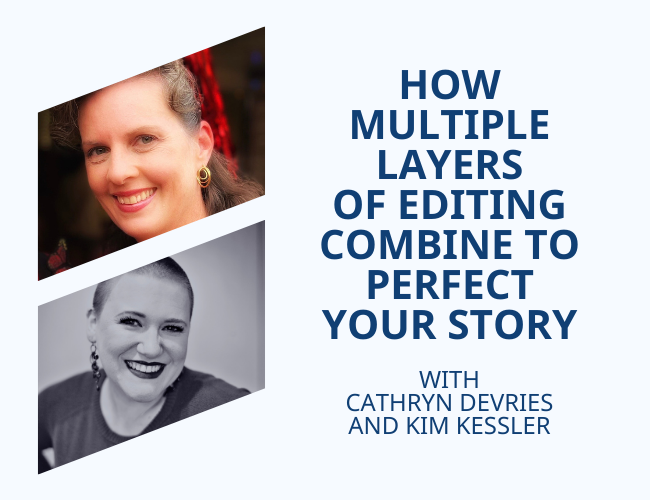The best novels combine rock-solid story structure with scenes that are unputdownable on every page. Here’s how one writer and two editors polished a story at every level.

If you want to move your reader in every moment, keep them hooked on every page, you need to refine your scenes until each one is unputdownable.
And that refinement? It’s SUCH a joy. It’s my favorite thing to do and it will transform your entire story.
But in order to make every scene matter, you first need to make sure you have all the right scenes in all the right places.
The big-picture story structure can’t be kinda-sorta-maybe working. It needs to be locked in, watertight.
Otherwise, all those beautiful scenes won’t build to anything. They might be pretty on their own. But they won’t create compelling narrative drive, an irresistible build to the cathartic payoff your readers can’t get enough of.
So how do you do it? How do you get your macro storytelling crystal clear and refine every scene into its most powerful form?
In this episode, I want to share with you the story of how one writer did just that. You’ll hear how Cathryn leveraged multiple revision passes to transform her manuscript from a massive pile of words that made her cringe to a story she’s immeasurably proud of.
It’s also a tale of two editors—because Cathryn worked with both me and my colleague Kim to make her story shine on every level.
Most of all, it’s a story of mastering two storytelling skills—the micro and the macro—and all the story magic you can unlock when you do.
Edit With Kim & Alice
In this episode, you’re going to hear from two editors: Kim Kessler, who specializes in big-picture story structure and early story development, and me, who specializes in scene-level revision and late-stage refining.
When it comes to editing, Kim and I go together like chocolate chips and cookies. One of our favorite ways to work is in tandem, where we both get to contribute our strengths to a writer’s story and support the writer together.
If the editing process you hear in this episode inspires you and you want to get our collective support on your story, reach out to us and tell us about your story!
Fill out the form on this page »
In the final box in the form, mention that you’re interested in working with me and Kim.
Whenever you’re ready to work with an editor, I’d love to hear about your story and see if we’re the right fit!
Cathryn’s Editing Path to a Novel She Loves
Cathryn is a fantasy author, and Kim is a developmental editor and book coach, as well as an author herself. Cathryn came to us back in 2023 with a manuscript that she’d self-edited through seven drafts, but still couldn’t quite get to work.
And for about a year, the three of us got to work on her story together.
It was a really, really cool experience for all three of us. Cathryn leveled up her manuscript into a novel that she’s now incredibly proud of. She queried it last fall and is now finding its perfect publishing home.
And Kim and I had just a wonderful time collaborating together and with Cathryn, bringing each of our editing superpowers to the table to help Cathryn shape the story she truly wanted to tell.
In this conversation, you’ll hear what Cathryn focused on in each draft of her revision process. You’ll also hear what it was like to get feedback from not one, but two editors. You’ll hear about how Cathryn’s manuscript transformed over the course of our work, and also how her editing process transformed.
And of course, at the end, you’ll hear what Cathryn and Kim both love about the editing journey we went through together.
After the conversation, I’ll share four highlights that stood out to me that you can apply in your own editing process. So if you’d like just the cliff’s notes, you can jump to the last ten minutes or so.
That said, I loved this conversation, and I think you’ll really enjoy it too. It’s such a cool look at what it actually takes to go from cringing at an early draft to absolutely loving your finished manuscript.
4 Editing Principles From Cathryn’s Process
There’s a lot you can take from that conversation. Here are the four things that stuck out to me:
1. Cathryn wrote and revised ten drafts of her novel to get to the version she’s proud to publish.
That’s ten drafts from “never written a book before” to the version she submitted to agents and publishers and is now walking through the publication process.
She worked through the first seven drafts on her own and with the help of early readers, including her daughter, trusted friends, and some betas.
Then she reworked the scene list with Kim, revised the manuscript based on that scene list, revised the manuscript again with me, and did a final pass with last adjustments as she prepared it for querying.
Writers ask me all the time how many drafts it takes to create a book—specifically, to create a book that has a good shot at traditional publication. There’s no one answer to that question.
But in Cathryn’s case, the answer was ten drafts.
2. Cathryn discovered her true story through this editing process.
Did you catch it? Here, I’ll play it back:
I discovered the true story through this process. It didn’t feel vague when I brought it to Kim, but it was vague. And by the time I’d finished working with the both of you, it was not vague anymore. It was clarified, refined. Every piece was moving together like clockwork to roll this story progressively on the arc that it needed to take.
This right here is the magic of editing. The editing process is where we figure out the story you really want to tell.
You have vision already for the story you want to tell. But I bet it’s more hazy than you think.
In the editing process, we sharpen that vision to crystal clarity, and then we use it to transform the whole story.
3. Cathryn began making connections between the macro and the micro levels of her story.
Once she nailed down her scene list with Kim and shifted to work with me in the Story Refinery, she was basically doing two passes of revision on her manuscript at the same time.
In one pass, she was making the big-picture, content-level, structural changes required to make the manuscript match the scene list. She was moving scenes around, cutting pieces that needed cutting, and writing new material that she and Kim had mapped out.
In the other pass, she was going much more slowly through each scene with me. We averaged one scene per week, and sometimes we’d spend multiple weeks working on the same scene.
Because Kim had helped Cathryn think big-picture about her story, and I helped her see how each detail mattered on the page, and especially because she was doing that work simultaneously, Cathryn began to see connections between the micro and the macro all the way through.
She got really comfortable using the same editing frameworks at every level of story, which allowed her to make every scene really sharp while also connecting each scene to the entire rest of the story in profound and powerful ways.
4. All this storytelling magic is easier to access when you do it together in community.
Cathryn and Kim and I have formed a trustworthy creative pod where Cathryn comes up with incredible stories and Kim and I are just delighted to jump in and support her vision.
If you would like to get support from Kim and me together like this, we’d be so happy to chat with you and see if we’re a good fit for you and your story. You can fill out the form on this page and just make a note in the form when you do that you heard this episode and you’re interested in working with both Kim and me.
But if Kim and I aren’t the community for your story, for any reason, that’s okay too! The bigger principle here is, I encourage you to find your own trustworthy creative pod.
Find your people, be they editors, book coaches, critique partners, alpha readers—whomever they are, find your people whom you can trust and who help you be your most creative storytelling self.
I find over and over and over that storytelling together is so much more inspiring, exciting, and fun than storytelling alone.
Recap: Editing Process Takeaways
And there you have it—my four takeaways from this conversation. Here they are again:
- Cathryn wrote and revised ten drafts of her novel to get to the version she’s proud to publish.
- It was through the big-picture story structuring work with Kim that Cathryn felt that she discovered the true story she was telling.
- Because Cathryn was so intentionally revising both the big picture and the scene-level refinements, in order but also in some ways simultaneously, she was able to make powerful connections between the macro and micro levels of her story.
- All this storytelling magic is easier to access when you do it together in community.
Go Deeper With Further Listening
If you’d like to go deeper into some of the ideas we discussed here, I have three more episodes of Your Next Draft to recommend to you.
First, there’s episode 76: Scene Workshop: Hook Your Readers in Chapter One with Cathryn deVries.
In that episode, you’ll get to hear Cathryn and me actually workshop the first scene of her novel together. It’s a little glimpse into the work we did for her entire manuscript in the Story Refinery.
Next, I recommend checking out episode 42: The 6 Essential Elements of Every Novel, Act, and Scene.
Cathryn, Kim and I talked a lot about Story Grid’s Five Commandments of storytelling. In episode 42, I break each one of those commandments down and show you what they are and how they work.
Yes, I call them six elements rather than five commandments. But they’re the same thing.
And finally, if you want to hear more about my slow clap for a scene well edited, check out episode 60: The Most Joyful Editing Feedback I Ever Give.
Read Cathryn’s Stories + Get Free Coaching With Kim
I highly recommend checking out Cathryn’s stories—especially Lightning Hunter, since I got to workshop that one with her.
And you don’t want to sleep on Kim’s Novel Hotline Live. It’s a couple hours of free novel coaching every month, and she solves so many story challenges with writers in that space. So run, don’t walk to the show notes to go to her website and RSVP for the next hotline.
And that’s everything. You’ve got takeaways, you’ve got recommended next listens, and you’ve got great stories to read and free coaching to explore.
Thanks for joining me and Cathryn and Kim for this conversation. I hope you chase down any of those links in the show notes that sound exciting to you.
And most of all, I hope you find your own trustworthy creative pod to support you as you refine your manuscript into a story you’re really freaking proud of.
Happy editing!
